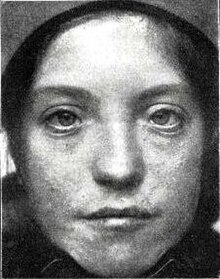| Waardenburg syndrome | |
|---|---|
| Other names | Klein–Waardenburg syndrome (type 3), Shah–Waardenburg syndrome (type 4) |
 | |
| Facial features of Waardenburg syndrome type 1 (from Jan van der Hoeve's description, 1916) | |
| Specialty | Medical genetics |
Waardenburg syndrome is a group of rare genetic conditions characterised by at least some degree of congenital hearing loss and pigmentation deficiencies, which can include bright blue eyes (or one blue eye and one brown eye), a white forelock or patches of light skin. These basic features constitute type 2 of the condition; in type 1, there is also a wider gap between the inner corners of the eyes called telecanthus, or dystopia canthorum.[1] In type 3, which is rare, the arms and hands are also malformed, with permanent finger contractures or fused fingers, while in type 4, the person also has Hirschsprung's disease.[2][3] There also exist at least two types (2E and PCWH) that can result in central nervous system (CNS) symptoms such as developmental delay and muscle tone abnormalities.[4]
The syndrome is caused by mutations in any of several genes that affect the division and migration of neural crest cells during embryonic development (though some of the genes involved also affect the neural tube).[5] Neural crest cells are stem cells left over after the closing of the neural tube that go on to form diverse non-CNS cells in different parts of the body, including melanocytes, various bones and cartilage of the face and inner ear and the peripheral nerves of the intestines.[6] Type 1 is caused by a mutation in the PAX3 gene, while the gene that most often causes type 2 when mutated is MITF.[1][7] Type 3 is a more severe presentation of type 1 and is caused by a mutation in the same gene, while type 4 is most often caused by a mutation in SOX10.[2][8] Mutations in other genes can also cause the different types, and some of these have been given their own lettered subtypes. Most types are autosomal dominant.
The estimated prevalence of Waardenburg syndrome is 1 in 42,000.[5][8] Types 1 and 2 are the most common, comprising approximately half and a third of cases, respectively, while type 4 comprises a fifth and type 3 less than 2% of cases.[8] An estimated 2–5% of congenitally deaf people have Waardenburg syndrome.[8] Descriptions of the syndrome date back to at least the first half of the 20th century, however it is named after Dutch ophthalmologist and geneticist Petrus Johannes Waardenburg, who described it in 1951.[9][10] Its subtypes were progressively discovered in the following decades and had genes attributed to them mostly in the 1990s and 2000s.
- ^ a b Cite error: The named reference
:132was invoked but never defined (see the help page). - ^ a b Cite error: The named reference
:62was invoked but never defined (see the help page). - ^ Cite error: The named reference
:23was invoked but never defined (see the help page). - ^ Cite error: The named reference
:52was invoked but never defined (see the help page). - ^ a b Cite error: The named reference
:3was invoked but never defined (see the help page). - ^ Cite error: The named reference
:5was invoked but never defined (see the help page). - ^ Cite error: The named reference
:03was invoked but never defined (see the help page). - ^ a b c d Cite error: The named reference
:122was invoked but never defined (see the help page). - ^ Cite error: The named reference
:4was invoked but never defined (see the help page). - ^ Waardenburg PJ (September 1951). "A New Syndrome Combining Developmental Anomalies of the Eyelids, Eyebrows and Noseroot with Pigmentary Anomalies of the Iris and Head Hair and with Congenital Deafness; Dystopia canthi medialis et punctorum lacrimalium lateroversa, Hyperplasia supercilii medialis et radicis nasi, Heterochromia iridum totalis sive partialis, Albinismus circumscriptus (leucismus, poliosis) et Surditas congenita (surdimutitas)". Am. J. Hum. Genet. 3 (3): 195–253. PMC 1716407. PMID 14902764.